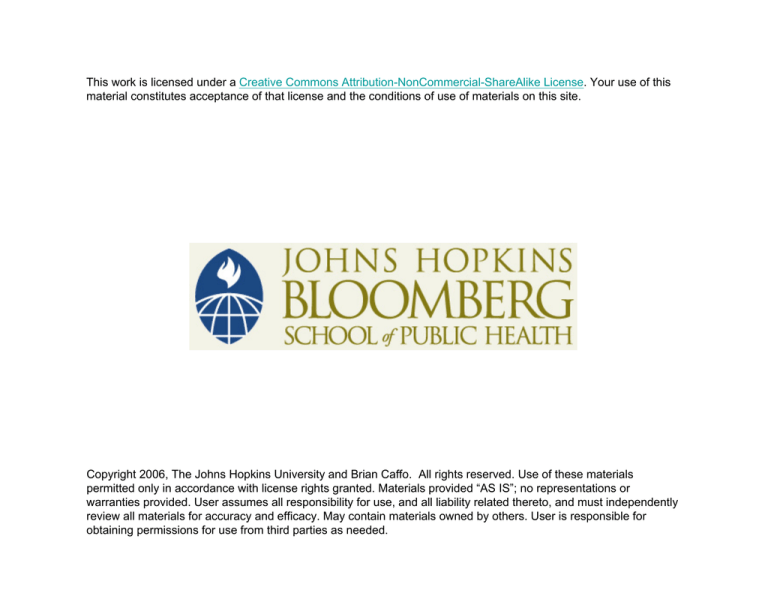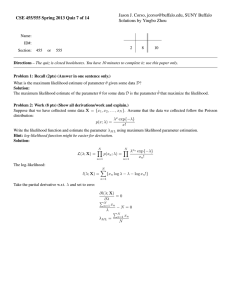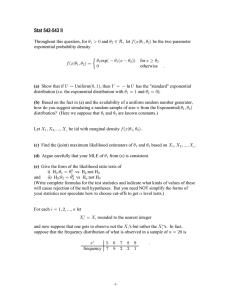
This work is licensed under a Creative Commons Attribution-NonCommercial-ShareAlike License. Your use of this
material constitutes acceptance of that license and the conditions of use of materials on this site.
Copyright 2006, The Johns Hopkins University and Brian Caffo. All rights reserved. Use of these materials
permitted only in accordance with license rights granted. Materials provided “AS IS”; no representations or
warranties provided. User assumes all responsibility for use, and all liability related thereto, and must independently
review all materials for accuracy and efficacy. May contain materials owned by others. User is responsible for
obtaining permissions for use from third parties as needed.
Outline
1. Define likelihood
2. Interpretations of likelihoods
3. Likelihood plots
4. Maximum likelihood
5. Likelihood ratio benchmarks
Likelihood
•A
common and fruitful approach to statistics is to assume that the data arises from a family of distributions indexed by a parameter that represents a useful
summary of the distribution
• The likelihood of a collection of data is the joint den-
sity evalued as a function of the parameters with the
data fixed
• Likelihood
analysis of data uses the likelihood to perform inference regarding the unknown parameter
Likelihood
Given a statistical probability mass function or density,
say f (x, θ), where θ is an unknown parameter, the likelihood is f viewed as a function of θ for a fixed, observed
value of x.
Interpretations of likelihoods
The likelihood has the following properties:
1. Ratios of likelihood values measure the relative evidence of one value of the unknown parameter to another.
2. Given a statistical model and observed data, all of the
relevant information contained in the data regarding
the unkown parameter is contained in the likelihood.
3. If {Xi} are independent events, then their likelihoods
multiply. That is, the likelihood of the parameters
given all of the Xi is simply the produce of the individual likelihoods.
Example
• Suppose
• Recall
that we flip a coin with success probability θ
that the mass function for x
f (x, θ) = θx(1 − θ)1−x
for θ ∈ [0, 1].
where x is either 0 (Tails) or 1 (Heads)
• Suppose
• The
that the result is a head
likelihood is
L(θ, 1) = θ1(1 − θ)1−1 = θ
for θ ∈ [0, 1].
• Therefore, L(.5, 1)/L(.25, 1) = 2,
• There
is twice as much evidence supporting the hypothesis that θ = .5 to the hypothesis that θ = .25
Example cont’d
• Suppose
now that we flip our coin from the previous
example 4 times and get the sequence 1, 0, 1, 1
• The
likelihood is:
L(θ, 1, 0, 1, 1) = θ1(1 − θ)1−1θ0(1 − θ)1−0θ1(1 − θ)1−1θ1(1 − θ)1−1
= θ3(1 − θ)1
• This
likelihood only depends on the total number of
heads and the total number of tails; we might write
L(θ, 0, 3) for shorthand
• Now
consider L(.5, 0, 3)/L(.25, 0, 3) = 5.33
• There
is over five times as much evidence supporting
the hypothesis that θ = .5 over that θ = .25
Plotting likelihoods
• Generally,
we want to consider all the values of θ between 0 and 1
•A
likelihood plot displays θ by L(θ, x)
• Usually,
it is divided by its maximum value so that its
height is 1
• Because
the likelihood measures relative evidence, dividing the curve by its maximum value (or any other
value for that matter) does not change its interpretation
0.0
0.2
0.4
0.6
θ
0.8
1.0
0.0
0.2
0.4
0.6
Likelihood
0.8
1.0
Maximum likelihood
• The
value of θ where the curve reaches its maximum
has a special meaning
• It
is the value of θ that is most well supported by the
data
• This
point is called the maximum likelihood estimate (or MLE) of θ
M LE = argmaxθ L(θ, x).
• Another
interpretation of the MLE is that it is the
value of θ that would make the data that we observed
most probable
Maximum likelihood, coin example
• The
maximum liklelihood estimate for θ is always the
proprotion of heads
• Proof:
Let x be the number of heads and n be the
number of trials
• Recall
L(θ, x) = θx(1 − θ)n−x
• It’s
easier to maximize the log-likelihood
l(θ, x) = x log(θ) + (n − x) log(1 − θ)
Cont’d
• Taking
the derivative we get
d
x n−x
l(θ, x) = −
dθ
θ 1−θ
• Setting
equal to zero implies
x
x
(1 − )θ = (1 − θ)
n
n
is clearly solved at θ = nx
• Notice that the second derivative
• Which
x
n−x
d2
l(θ, x) = − 2 −
<0
2
2
dθ
θ
(1 − θ)
provided that x is not 0 or n
What constitutes strong evidence?
• Again
imagine an experiment where a person repeatedly flips a coin
• Consider
the possiblity that we are entertaining three
hypotheses: H1 : θ = 0, H2 : θ = .5, and H3 : θ = 1
Outcome X P (X | H1) P (X | H2) P (X | H3) L(H1)/L(H2) L(H3)/L(H2)
H
0
.5
1
0
2
T
1
.5
0
2
0
HH
0
.25
1
0
4
HT
0
.25
0
0
0
TH
0
.25
0
0
0
TT
1
.25
0
4
0
HHH
0
.125
1
8
0
HHT
0
.125
0
0
0
HTH
0
.125
0
0
0
THH
0
.125
0
0
0
HTT
0
.125
0
0
0
THT
0
.125
0
0
0
TTH
0
.125
0
0
0
TTT
1
.125
0
0
8
Benchmarks
• Using
this example as a guide, researchers tend to
think of a likelihood ratio
◮ of 8
as being moderate evidence
◮ of 16 as being moderately strong evidence
◮ of 32 as being strong evidence
of one hypothesis over another
• Because
of this, it is common to draw reference lines
at these values on likelihood plots
• Parameter
values above the 1/8 reference line, for example, are such that no other point is more than 8
times better supported given the data









